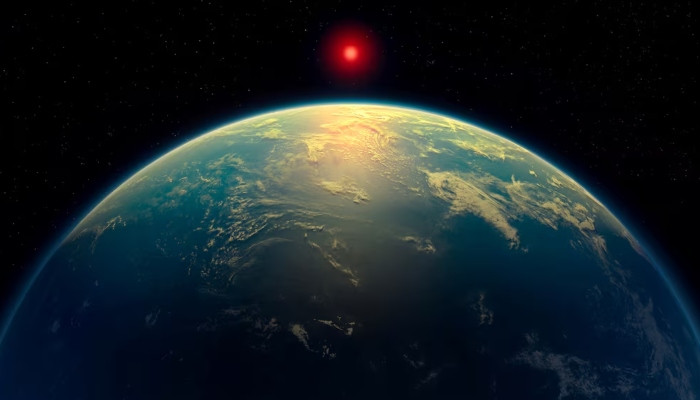Possible Signs of Life Detected on Exoplanet K2-18b
In a potentially groundbreaking discovery, scientists utilizing the James Webb Space Telescope have reported the most compelling evidence to date of potential life beyond our solar system. They detected chemical indicators of gases in the atmosphere of an exoplanet that, on Earth, are exclusively produced through biological means.
The gases in question, dimethyl sulfide (DMS) and dimethyl disulfide (DMDS), were identified during Webb’s observation of planet K2-18b. On Earth, these gases are emitted by living organisms, mainly by marine phytoplankton like algae.
Researchers suggest this finding implies that the planet might be abundant with microbial life. However, they clarify that this is not an announcement of the discovery of living organisms. Instead, it is a potential biosignature, indicating a biological process. The scientists advise caution and emphasize the need for further study.
The researchers expressed enthusiasm about their findings. According to astrophysicist Nikku Madhusudhan from the University of Cambridge’s Institute of Astronomy, who is also the lead author of the study published in the Astrophysical Journal Letters, these are initial indications of a potentially inhabited alien world.
“This marks a transformative point in the search for extraterrestrial life. We’ve shown the feasibility of detecting biosignatures on potentially habitable planets using current technology, ushering in the era of observational astrobiology,” stated Madhusudhan.
Madhusudhan mentioned ongoing investigations into signs of life within our solar system, including claims of possible habitable environments on Mars, Venus, and various icy moons.
K2-18b’s mass is about 8.6 times that of Earth, and its diameter is approximately 2.6 times larger. The exoplanet orbits within the “habitable zone” of a red dwarf star—a region where liquid water could exist on the surface of the planet. This star, which is smaller and emits less light compared to our sun, is situated approximately 124 light-years away from Earth in the constellation Leo. Another planet has also been found orbiting this star.
Since the 1990s, roughly 5,800 exoplanets have been identified. Scientists have proposed the existence of hycean worlds, exoplanets characterized by liquid water oceans habitable for microorganisms and hydrogen-rich atmospheres.
Previous observations via the Webb telescope, which was launched in 2021 and began operations in 2022, revealed methane and carbon dioxide in K2-18b’s atmosphere. This was the first instance of discovering carbon-based molecules in the atmosphere of an exoplanet within a star’s habitable zone.
“Based on the data obtained from JWST so far, the most plausible scenario is that K2-18b is a hycean world brimming with life,” explained Madhusudhan. “Nonetheless, we must maintain an open mind and investigate other possibilities.”
Madhusudhan stated that if hycean worlds exist, “we could be observing microbial life, perhaps similar to what is present in Earth’s oceans.” These oceans are theorized to be warmer than Earth’s. When questioned about the possibility of multicellular organisms or intelligent life, Madhusudhan responded, “We cannot address that question at this time. Our baseline assumption is simple microbial life.”
DMS and DMDS have been anticipated as significant biosignatures for exoplanets. Webb’s findings indicate a 99.7% confidence level for the presence of one or both gases in the planet’s atmosphere, leaving a 0.3% chance of statistical error.
The concentration of these gases in the atmosphere exceeded 10 parts per million by volume.
“This concentration is thousands of times greater than the concentrations observed in Earth’s atmosphere and cannot be explained without biological activity, based on what we currently know,” Madhusudhan clarified.
Scientists not involved in the study advised caution.
Christopher Glein, principal scientist at the Space Science Division of the Southwest Research Institute in Texas, commented, “The comprehensive data from K2-18b make it a captivating world.”
“These latest data offer valuable insights. However, it’s essential to rigorously validate the data. I am eager to see further, independent analyses of the data in the near future.”
K2-18b belongs to the sub-Neptune category of planets, which have diameters larger than Earth but smaller than Neptune, the smallest gas planet in our solar system.
To ascertain the atmospheric composition of an exoplanet, astronomers scrutinize the light emanating from its host star as the planet transits in front of it from Earth’s perspective, a method known as the transit method. During transit, Webb detects a reduction in stellar brightness, with a small portion of starlight traversing the planetary atmosphere before being detected by the telescope. This allows scientists to identify the gases present in the planet’s atmosphere.
Webb’s prior observations hinted at the presence of DMS. The recent observations employed a different instrument and a different wavelength range of light.
Madhusudhan described the “Holy Grail” of exoplanet science as finding evidence of life on an Earth-like planet beyond our solar system. He noted that humans have pondered the question of whether we are alone in the universe for millennia and may soon be able to detect potential alien life on a hycean world.
However, Madhusudhan stressed the need for caution.
“Firstly, we must replicate the observations two to three times to ensure the reliability of the signal and increase the detection significance” to a level where the odds of a statistical anomaly are below roughly one in a million, Madhusudhan explained.
“Secondly, further theoretical and experimental studies are required to determine whether there is an abiotic mechanism (not involving biological processes) that could produce DMS or DMDS in an atmosphere similar to that of K2-18b. While previous research suggests they are robust biosignatures, even for K2-18b, we must remain open-minded and consider alternative possibilities,” Madhusudhan concluded.
Therefore, the findings come with a significant “if” regarding whether the observations are attributable to life, and Madhusudhan stressed that it is not beneficial to claim prematurely that life has been detected.



Comments (0)
No comments yet. Be the first to comment!
Leave a Comment